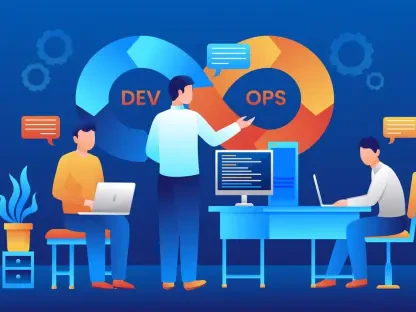Overview of the Data Engineering Challenge
In today’s fast-evolving digital landscape, data engineering stands as a cornerstone of organizational success, yet a staggering skills shortage threatens to derail progress across the global IT industry, with the explosion of AI-driven intelligent agents reshaping how businesses operate. The demand for robust data foundations has never been more critical. However, many companies find themselves grappling with a severe lack of skilled professionals to build and maintain these vital systems, creating a bottleneck that slows innovation and hampers transformation.
This report delves into the current state of data engineering, highlighting the growing importance of high-quality data pipelines for AI adoption. It examines the pervasive skills gap, the systemic challenges compounding the issue, and the innovative solutions emerging to address these hurdles. By focusing on platforms like IBM Watsonx.Data, the analysis aims to provide a comprehensive view of how the industry can bridge this critical divide.
The urgency of this issue cannot be overstated, as organizations race to harness data for competitive advantage. As AI continues to permeate every sector, the ability to manage and integrate data effectively becomes a defining factor in business outcomes. This exploration sets the stage for understanding both the obstacles and the opportunities that lie ahead in the data engineering domain.
Understanding the Data Engineering Landscape and Skills Shortage
The data engineering field has become a linchpin of the global IT ecosystem, supporting everything from analytics to machine learning initiatives. As businesses increasingly rely on data to drive decisions, the role of data engineers in designing, building, and maintaining pipelines has grown exponentially. Yet, the industry faces a profound challenge: a shortage of qualified professionals to meet this escalating demand, stunting growth in data-driven transformation.
A key driver of this urgency is the rise of AI-powered intelligent agents, which depend on clean, accessible data to function effectively. These agents are transforming workflows by automating processes and enhancing productivity, but without a strong data foundation, their potential remains untapped. The skills gap directly impacts the ability to create such infrastructure, leaving many organizations struggling to keep pace with technological advancements.
Industry reports underscore the severity of this workforce constraint, with predictions indicating that by 2026, a significant majority of organizations will face shrinking talent pools. Major players in the market, alongside technological influences like AI and automation, are pushing for solutions, but the need for robust data systems remains paramount. This dynamic highlights the critical intersection of talent availability and infrastructure development in shaping the future of data engineering.
Industry Trends and Market Dynamics
Emerging Trends in Data Engineering
The data engineering sector is witnessing a notable shift toward intelligent, user-centric integration solutions that aim to simplify complex tasks. This trend reflects a broader movement to make data management accessible to a wider audience, reducing dependency on highly specialized talent. Innovations such as agentic data integration, powered by natural language processing, are enabling users to create pipelines through intuitive commands, democratizing access across skill levels.
Another significant development is the growing demand for flexibility to cater to diverse user needs, from business analysts to seasoned engineers. This push for adaptability is driving the adoption of unified frameworks that integrate various authoring styles, ensuring consistency and efficiency. Such platforms are becoming essential as organizations seek to streamline operations without expanding headcount.
Market drivers like widespread AI adoption and shifting consumer behavior toward self-service tools are further accelerating these changes. The emphasis on scalability and ease of use is opening new opportunities for businesses to optimize data processes. As these trends evolve, they signal a transformative period in how data engineering tasks are approached and executed.
Market Insights and Growth Projections
Recent studies reveal the depth of the skills shortage, with projections suggesting that by 2026, up to 90% of organizations may experience workforce reductions due to talent scarcity. This alarming statistic underscores the urgent need for solutions that can mitigate reliance on specialized expertise. The demand for high-quality data pipelines continues to surge, fueled by the integration of AI-driven productivity tools in business operations.
Looking ahead, the market for data integration platforms is expected to grow significantly, driven by the need to address skills constraints through automation and user-friendly interfaces. From 2025 to 2027, investments in these technologies are anticipated to rise as companies prioritize efficient data management. This growth trajectory reflects a broader industry shift toward tools that empower non-technical users while maintaining robust governance.
The evolution of data platforms is also poised to reshape how organizations handle integration challenges. Future developments are likely to focus on enhancing accessibility and reducing operational overhead, ensuring that even smaller teams can manage complex data environments. These projections highlight the critical role of innovation in overcoming current limitations and fostering resilience in the sector.
Challenges in Building Robust Data Foundations
One of the foremost obstacles in data engineering is the burden of technical debt, often accumulated from repeatedly rebuilding pipelines to adapt to new architectures. This repetitive cycle consumes valuable resources and diverts attention from strategic initiatives. As systems evolve, the cost of maintaining outdated or patchwork solutions becomes a significant barrier to progress.
Tool sprawl presents another pressing issue, with fragmented systems requiring niche expertise to operate effectively. The proliferation of disparate tools leads to inefficiencies and complicates governance, as teams struggle to maintain consistency across platforms. This fragmentation often results in siloed data environments, further hindering the ability to derive actionable insights.
Visibility into pipeline performance remains a persistent challenge, as quality issues frequently go undetected until they disrupt downstream applications. Addressing these disruptions demands proactive strategies, such as consolidating tools into unified systems and empowering non-technical users to participate in data processes. Simplifying the technology stack and enhancing transparency are crucial steps toward building more resilient data foundations.
Regulatory and Compliance Considerations in Data Integration
Navigating the regulatory landscape is a vital aspect of data engineering, with strict governance and security standards shaping how data is managed. Compliance with these regulations ensures that access to high-quality data remains governed and secure, protecting both organizations and their stakeholders. Failure to adhere to these standards can result in significant legal and financial repercussions.
The impact of regulatory changes on data operations cannot be ignored, as evolving policies often necessitate adjustments to integration practices. Unified frameworks play a pivotal role in maintaining consistency amid such shifts, providing a structured approach to compliance. These systems help organizations adapt to new requirements without overhauling existing processes.
Observability and hybrid deployment flexibility are also essential in meeting compliance demands, offering the ability to monitor data flows and deploy solutions across diverse environments. By integrating these capabilities, companies can ensure accountability and traceability in their data operations. This focus on regulatory adherence underscores the importance of building systems that prioritize both security and adaptability.
Future Directions for Data Engineering and Skills Gap Solutions
The future of data engineering is being shaped by emerging technologies like agentic integration and AI-driven tools, which promise to redefine how data tasks are performed. These advancements aim to lower barriers to entry, enabling users of varying expertise to contribute to data management. Such innovations are expected to play a central role in addressing the ongoing skills shortage.
Market disruptors, including the widespread adoption of self-service data platforms, are likely to accelerate this transformation. These platforms cater to consumer preferences for low-code and no-code solutions, fostering greater independence among users. As these tools gain traction, they are set to influence growth areas by reducing the need for extensive technical training.
Global workforce trends, coupled with regulatory shifts and continuous innovation, will further define the industry’s trajectory. The emphasis on inclusivity and efficiency suggests a move toward more collaborative and scalable data environments. Keeping pace with these developments will be essential for organizations aiming to remain competitive in an increasingly data-centric world.
Reflecting on Findings and Next Steps
Looking back, this report illuminated the profound challenges posed by the data engineering skills gap, which has constrained organizations in their pursuit of AI-driven transformation. Systemic issues such as technical debt and tool sprawl have compounded the problem, making it difficult to establish the robust data foundations necessary for success. The analysis also revealed the transformative potential of solutions like IBM Watsonx.Data, which empower diverse users through agentic integration and unified frameworks.
Moving forward, actionable steps include adopting these unified platforms to streamline operations and reduce reliance on specialized talent. Organizations are encouraged to explore hybrid deployment options and prioritize data observability to enhance governance and scalability. Investing in user-centric tools that support varied skill sets has emerged as a strategic imperative to ensure long-term resilience.
As the industry continues to evolve, fostering a culture of continuous learning and adaptation stands out as a critical consideration. Embracing innovative approaches to data integration has proven to be a pathway to not only bridge the skills gap but also unlock new opportunities for growth. The journey ahead requires a commitment to leveraging technology to empower teams and build sustainable data ecosystems.









